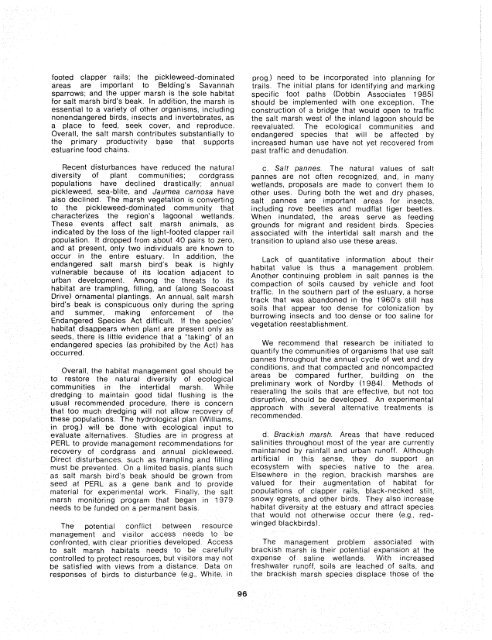The Ecology of Tijuana Estuary, California: An Estuarine Profile
The Ecology of Tijuana Estuary, California: An Estuarine Profile
The Ecology of Tijuana Estuary, California: An Estuarine Profile
You also want an ePaper? Increase the reach of your titles
YUMPU automatically turns print PDFs into web optimized ePapers that Google loves.
footed clapper rails; the pickleweed-dominated<br />
areas are important to gelding's Savannah<br />
sparrows; and the upper marsh is the sole habitat<br />
for salt marsh bird's beak. In addition, the marsh is<br />
essential to a variety <strong>of</strong> other organisms, including<br />
nonendangered birds, insects and invertebrates, as<br />
a place to feed, seek cover, and reproduce.<br />
Overall, the salt marsh contributes substantially to<br />
the primary productivity base that supports<br />
estuarine food chains.<br />
prog.) need to be incorporated into planning for<br />
trails. <strong>The</strong> initial plans for identifying and marking<br />
specific foot paths (Dobbin Associates 1985)<br />
should be implemented with one exception. <strong>The</strong><br />
construction <strong>of</strong> a bridge that would open to traffic<br />
the salt marsh west <strong>of</strong> the inland lagoon should be<br />
reevaluated. <strong>The</strong> ecological communities and<br />
endangered species that will be affected by<br />
increased human use have not yet recovered from<br />
past traffic and denudation.<br />
Recent disturbances have reduced the natural<br />
diversity <strong>of</strong> plant communities; cordgrass<br />
populations have declined drastically; annual<br />
pickleweed, sea-blite, and Jaumea carnosa have<br />
also declined. <strong>The</strong> marsh vegetation is convert~ng<br />
to the pickleweed-dominated community that<br />
characterizes the region's lagoonal wetlands.<br />
<strong>The</strong>se events affect salt marsh animals, as<br />
indtcated by the loss <strong>of</strong> the light-footed clapper rail<br />
population. It dropped from about 40 pairs to zero,<br />
and at mesent, onlv two individuals are known to<br />
occur in the entlre estuary In addition, the<br />
endangered salt marsh bird's beak IS h~ghly<br />
vulnerable because <strong>of</strong> ~ts locatron adjacent to<br />
urban development. Among the threats to ~ts<br />
hab~tat are trampling, filling, and (along Seacoast<br />
Drive) ornamental piantings. <strong>An</strong> annual, salt marsh<br />
bird's beak IS conspicuous only durlng the spring<br />
and summer, making enforcement <strong>of</strong> the<br />
Endangered Species Act d~fficuit if the species'<br />
habitat disappears when plant are present only as<br />
seeds, there is llttle evidence that a "taking" <strong>of</strong> an<br />
endangered specles (as prohibited by the Act) has<br />
occurred<br />
c. Salt pannes. <strong>The</strong> natural values <strong>of</strong> salt<br />
pannes are not <strong>of</strong>ten recognized, and, in many<br />
wetlands, proposals are made to convert them to<br />
other uses. During both the wet and dry phases,<br />
salt pannes are important areas for insects,<br />
including rove beetles and mudflat tiger beetles,<br />
When inundated, the areas serve as feeding<br />
grounds for migrant and resident birds. Species<br />
associated with the intertidal salt marsh and the<br />
transition to upland also use these areas.<br />
Lack <strong>of</strong> quantitative information about their<br />
habitat value is thus a management problem.<br />
<strong>An</strong>other continuing problem in salt pannes is the<br />
compaction <strong>of</strong> soils caused by vehicle and foot<br />
traffic. In the southern part <strong>of</strong> the estuary, a horse<br />
track that was abandoned in the 1960's still has<br />
soils that appear too dense for colonization by<br />
burrowing insects and too dense or too saline for<br />
vegetation reestablishment.<br />
We recommend that research be initiated to<br />
quantify the communities <strong>of</strong> organisms that use salt<br />
pannes throughout the annual cycle <strong>of</strong> wet and dry<br />
condit~ons, and that compacted and noncompacted<br />
Overall. the habitat management goal should be areas be further, on the<br />
to restore the natural diversity <strong>of</strong> ecological<br />
work <strong>of</strong> Nordby (1984) Methods <strong>of</strong><br />
comrnunlties " the Intertidal marsh reaeratlng the soils that are effective, but not too<br />
dredging to maintain good flushing Is the disruptlve, should be developed <strong>An</strong><br />
usual recommended procedure, there IS concern<br />
approach with several alternative treatments IS<br />
that too much dredging will not allow recovery <strong>of</strong><br />
these populations. <strong>The</strong> hydrological plan<br />
recommended<br />
(Williams.<br />
in prog.) will be done w~th ecological ~nput to<br />
evaluate alternatives. Studies are ~n progress at d Brackfsh marsh Areas that have reduced<br />
PERL to provide management recommendations for salinltles throughout most <strong>of</strong> the year are currently<br />
recovery <strong>of</strong> cordgrass and annual plckleweed malntained by rainfall and urban run<strong>of</strong>f Although<br />
Olrecl disturbances, such as trampl~ng and filling artlficlal In this sense, they do support an<br />
must be prevented Qn a limited basis, plants such ecosystem with species native to the area<br />
as salt marsh bird's beak should be grown from Elsewhere in the reglon, brackish marshes are<br />
seed at PERL as a gene bank and to provide valued for their augmentation <strong>of</strong> habrtat for<br />
materral for exper~mental work. F~nally, the salt p~p~lati~n~ <strong>of</strong> clapper rails, black-necked stilt,<br />
marsh mon~torirrg program that began in 1979 snowy egrets, and other birds <strong>The</strong>y also Increase<br />
needs to be funded on a permanent basis<br />
habitat d~versity at the estuary and attract species<br />
that would not otherwise occur there (e.g, red-<br />
<strong>The</strong> potential conflict between resource<br />
management attd vrsttor access needs to be<br />
confronted, wrth clear prrorrtles developed Access <strong>The</strong> management problem assoc~ated with<br />
to salt marsh habitats needs to be carefully brackish marsh is thelr potential expansion at the<br />
controlled to protect resources, but vrsltors may not expense <strong>of</strong> saline wetlands. With increased<br />
be satisfied with views from a dlstance Data on freshwater run<strong>of</strong>f, soils are leached <strong>of</strong> salts, and<br />
responses <strong>of</strong> birds to disturbance (e.g., White, in the brack~sh marsh species d~splace those <strong>of</strong> the<br />
9 6

















